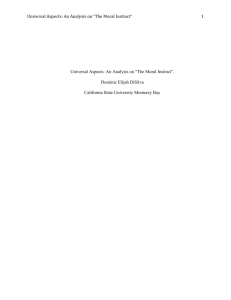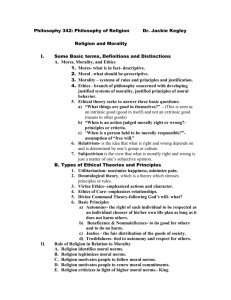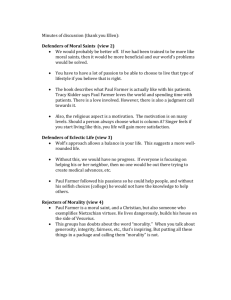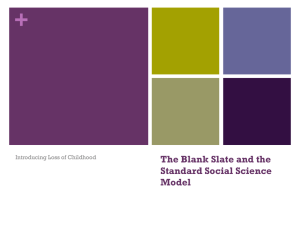Unit 1, Paper 1 A New Scientific Truth In his 2008 New York Times
advertisement
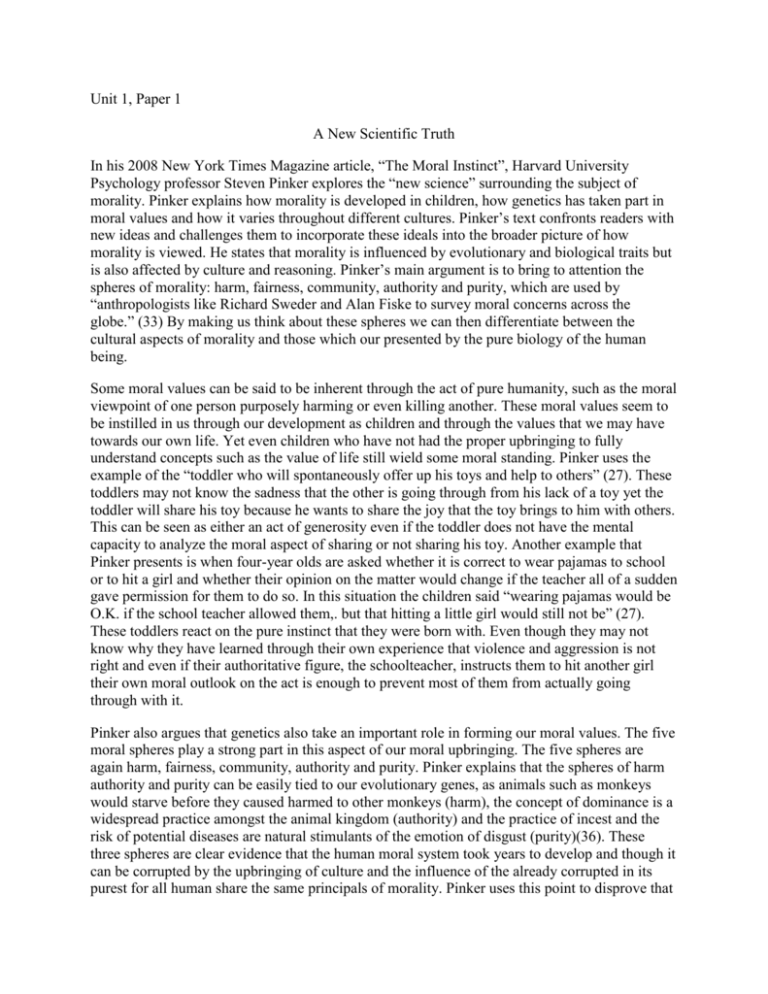
Unit 1, Paper 1 A New Scientific Truth In his 2008 New York Times Magazine article, “The Moral Instinct”, Harvard University Psychology professor Steven Pinker explores the “new science” surrounding the subject of morality. Pinker explains how morality is developed in children, how genetics has taken part in moral values and how it varies throughout different cultures. Pinker’s text confronts readers with new ideas and challenges them to incorporate these ideals into the broader picture of how morality is viewed. He states that morality is influenced by evolutionary and biological traits but is also affected by culture and reasoning. Pinker’s main argument is to bring to attention the spheres of morality: harm, fairness, community, authority and purity, which are used by “anthropologists like Richard Sweder and Alan Fiske to survey moral concerns across the globe.” (33) By making us think about these spheres we can then differentiate between the cultural aspects of morality and those which our presented by the pure biology of the human being. Some moral values can be said to be inherent through the act of pure humanity, such as the moral viewpoint of one person purposely harming or even killing another. These moral values seem to be instilled in us through our development as children and through the values that we may have towards our own life. Yet even children who have not had the proper upbringing to fully understand concepts such as the value of life still wield some moral standing. Pinker uses the example of the “toddler who will spontaneously offer up his toys and help to others” (27). These toddlers may not know the sadness that the other is going through from his lack of a toy yet the toddler will share his toy because he wants to share the joy that the toy brings to him with others. This can be seen as either an act of generosity even if the toddler does not have the mental capacity to analyze the moral aspect of sharing or not sharing his toy. Another example that Pinker presents is when four-year olds are asked whether it is correct to wear pajamas to school or to hit a girl and whether their opinion on the matter would change if the teacher all of a sudden gave permission for them to do so. In this situation the children said “wearing pajamas would be O.K. if the school teacher allowed them,. but that hitting a little girl would still not be” (27). These toddlers react on the pure instinct that they were born with. Even though they may not know why they have learned through their own experience that violence and aggression is not right and even if their authoritative figure, the schoolteacher, instructs them to hit another girl their own moral outlook on the act is enough to prevent most of them from actually going through with it. Pinker also argues that genetics also take an important role in forming our moral values. The five moral spheres play a strong part in this aspect of our moral upbringing. The five spheres are again harm, fairness, community, authority and purity. Pinker explains that the spheres of harm authority and purity can be easily tied to our evolutionary genes, as animals such as monkeys would starve before they caused harmed to other monkeys (harm), the concept of dominance is a widespread practice amongst the animal kingdom (authority) and the practice of incest and the risk of potential diseases are natural stimulants of the emotion of disgust (purity)(36). These three spheres are clear evidence that the human moral system took years to develop and though it can be corrupted by the upbringing of culture and the influence of the already corrupted in its purest for all human share the same principals of morality. Pinker uses this point to disprove that a “god” could have had no role in the development of human morality. If “God commanded us to torture a child. Would that make it all right, or would some other standard give us reasons to resist” (52). Pinker’s atheistic views on this theoretical situation allow us to distinguish faith from morality. Although faith is a guideline to good moral values it should not be the only means by which we live our moral lives. Pinker uses the analogy of a runaway train to prove differences in cultural morality. Providing a hypothetical situation on which the reader has a chance to save five lives at the cost of one, he first presents an example to which most people would take the trade off, pulling a lever that would divert the train towards the lone person and away from the group of five workers (18). In a second situation the reader is faced with the dilemma of having to toss one person off a bridge in exchange of being able to stop the train from hitting the five workers (19). These examples alone would have normal responses from people who have been raised in our culture as proven in the survey given to over “200,000 people from over one hundred different countries. conducted by psychologists Fiery Cushman and Liane Young and biologist Marc Hauser” (20). Yet in his third train analogy, Pinker brings in the mindset of a completely different culture, where the options are to allow the train to hit a schoolteacher or divert the train through a switch that would signal a group of six year olds to name their teddy bear Muhammad (30). To the average American this choice would be simple because the name Muhammad is completely irrelevant or even noteworthy to everyday moral standings. Yet Pinker states that to the Sudanese naming the teddy bear by the name of the founder of Islam is considered blasphemy. This moral difference was seen when the British schoolteacher who allowed her students to name the teddy bear after her most popular student was imprisoned and publicly flogged for these same charges (31). Steven Pinker’s challenges us to think about the differences between the cultural and biological/ genetic aspects of our moral value system. He shows other ways to view our morals and presents them in ways that question our own moral beliefs. This in turn enlightens us in the differences between our moral system and those of foreign cultures. He also ties those moral spheres that are linked by our genetic evolution to others through the common development of our childhood. Through these examples he shows how our moral system has evolved as science and theory brings new information into play. Works Cited Pinker, Steven. "The Moral Instinct." The New York Times Magazine 13 Jan. 2008. Paper 2 A Moral Puzzle Morality is such an obscure topic and deserves to be explored and even challenged on an analytical level. Because morality is an extremely important aspect in most people’s lives, it would almost be inhuman not to question and examine the concept itself. Steven Pinker, in his New York Times Magazine (2008) article “The Moral Instinct” dares to do just that. As a Harvard University professor of psychology, Pinker has an obvious understanding in the way that other people think and feel about situations. This is why in his text he questions the reason behind morality and challenges readers to question their own thoughts and feelings on the subject. Pinker also dissects what he calls the “new science” of morality and uses rhetorical strategies to connect his various claims, which argue that understanding this new science is beneficial to humanity. Pinker not only makes us think about what causes moral instinct, but also challenges us to use this newly proclaimed knowledge in a positive way. In this paper I will examine his strategic use of evidence to better understand his main viewpoints and claims, therefore expanding on what most people already know about moral sense. Understanding the points Pinker makes will, in one way or another, benefit us as human beings, just as his argument points out. There are a few very prominent claims that Pinker makes which reflect the central idea of his text the most. One of these claims is that moral instinct is inherited at birth. ( Pinker brings about the idea that we are born with a “moral grammar” which introduces his claim that morality is universal (25). He wants the reader to understand morality as widespread, thus implicating its significance. Pinker backs up his claim with multiple forms of evidence. He uses the analogy of morality and language to exemplify the concept that moral instinct is something inherited at birth. Showing that this analogy comes from a “legal scholar” (Pinker 25), Pinker adds credibility to his claim. He also gives evidence and authority for a list of human universals showing that there are concepts and emotions that everybody possesses, which are the basis of moral sense. “A list of human universals collected by the anthropologist Donald E. Brown includes many moral concepts and emotions, including a distinction between right and wrong; empathy; fairness; admiration of generosity; rights and obligations; prescription of murder, rape and other forms of violence; redress of wrongs; sanctions for wrongs against the community; shame; and taboos” (26) This list provides a clear explanation for the traits we are born with. Pinker then goes on to bring in other explanations for the inheritance of morality. Aspects of psychology, genetics, and neurology accompany the anthropologist’s list of human universals to further support Pinker’s claim. For example, “Neurologists Hanna and Antonio Damasio and their colleagues found that children who sustain severe injuries to their frontal lobes can grow up into callous and irresponsible adults, despite normal intelligence,” (29) Pinker proves to his audience that moral reasoning lies in the frontal lobes of the brain. He also uses an interesting rhetorical strategy and actually challenges the reader to rethink what was just discussed. “Yet for all the awe that may fill our minds when we reflect on an innate moral law within, the idea is at best incomplete” (Pinker 30). It is as if the author wants to contradict himself simply to keep the reader thinking and in constant discussion. To support this sudden change in discourse, Pinker brings back the analogy of the link between morality and language. He touches on the fact that language varies between cultures, implicating the idea that morality, as well, is variable. He first supports this by use of an anecdote that proves that a moral dilemma, which would seem to have universal agreement in resolving, actually varies between cultures (Pinker 30-31). Another claim in the text is essential in describing, as it is important in understanding Pinker’s central claim. Pinker explains how there are five basic moral spheres, common of all cultures, which are ordered differently depending on the culture. “Haidt counts five- harm, fairness, community, authority, and purity- and suggests that they are the primary colors of our moral sense” (34). Even after giving evidence with an outside authority, Pinker continues to support his claim that there are five basic moral foundations. He offers examples for each and also declares that there have been many surveys proving evidence that these five moral spheres do exists cross-culturally. This brings us to Pinker’s next most prominent claim, which proposes the idea that depending on cultural influences, the order in which moral values are prioritized differs. Now that his audience is convinced of these so called “moral spheres” Pinker moves on to explain how, although morality is universal, it is also variable (Pinker 39). He wants to stress the idea that, although we are born with an innate moral sense, the order of importance of our values is determined by our culture. Pinker provides evidence of differences between the moral beliefs of liberals and conservatives. “Haidt found that liberals put a lopsided moral weight on harm and fairness while playing down group loyalty, authority and purity. Conservatives instead place a moderately high weight on all five” (Pinker 40). This is another instance in which Pinker builds his credibility by providing evidence from another reliable source, while simultaneously providing an example for cultural differences and therefore variable morality. Variable morality and universal morality are just two of Pinker’s main points which bring him to the greater, more influential ideas in his text that more adequately pertain to his argument. Providing these two claims builds up to his most effective claim: that understanding the new science of morality is helpful in understanding our own moral sense. Pinker brings about the idea that some might think making morality into a science would make moral reasoning obsolete, however, he strongly argues against this (Pinker 57). Pinker does proceed to consider the idea that the moral sense can be illusive just like any other human sense. He provides examples of public discourse in this section of his text to support this concept. “There are many other issues for which we are too quick to hit the moralization button and look for villains rather than bug fixes” (Pinker 63). This shows Pinker’s understanding that although moral sense can be rationalized, it is still debatable and sometimes unclear. However, studying this “sense” (Pinker 4) on an analytical level helps us as humans to understand ourselves on a deeper level and in turn have a positive effect on personal aspects of life. “Man will become better when you show him what he is like” (Pinker 65). Pinker wants his audience to believe that there is nothing more essential to humanity itself than to be able to truly understand the inner self. Pinker builds ethos in these three important claims, as well as throughout the remainder of his text. He also structures his text in a very strategic way. Pinker’s main goal is to get the reader thinking deeper about something. One of the ways he does this is setting up his writing in a particular way. Throughout the text Pinker frequently introduces an idea, backs it up with evidence, and then rather than moving on from there, questions and even contradicts what he just supported. In this way Pinker keeps the audience constantly questioning. He wants the audience to start questioning things they have rarely even thought about before, and this is because most of his audience probably has never questioned the concept of morality. By persuading this thought process, Pinker brings the audience to consider his points of view and various explanations to situations; therefore building his ethos. Pinker is most likely trying to reach out to anyone who doesn’t already have a strong preconvention on morality or anyone who might be willing to change their convictions. He probably assumes the audience is, in one way or another, able to relate to him because of his casual tone. Some of the strategies Pinker uses to persuade the reader of his validity are the analogies he uses in the examples previously mentioned, his word choice, his interactive text which uses supporting evidence as well as rebuttals, and his ethos which was earlier discussed. The way Pinker structures his paper reflects his rational self because he tries to make sense of the obscure and is straightforward, engaging, and thought provoking. In conclusion, “A Moral Instinct” addresses a topic of morality as being more than significant, but somehow nearly overlooked. It shows us how we can use knowledge about ourselves to actually better ourselves, because if you understand the reason for your thoughts, your feelings, and your actions, you are more likely to have better control over them. Pinker’s claims that morality is universal and morality is variable show that everyone is born with a moral foundation but it is our culture that shapes our moral beliefs. His central claim that understanding the science of morality is beneficial to us shows us that we should not be afraid to learn about this new science, for it will bring us together to show what we really are capable of. It shows that understanding morality as a whole actually benefits the community. Pinker makes an effective argument, supports it with various forms of substantial evidence, makes it plausible by formulating his text in a rational way (promoting rational thought), and casually interacts with his potentially like-minded audience. The rhetorical strategies he used made emotional connections arise. He really brought he audience to not only read his text, but to feel it and question it, just as he is asking of them to do with the concept of morality. Pinker appears to be an extremely credible author and brings the most powerful element into the end of his article, pulling together connections between his many claims.



